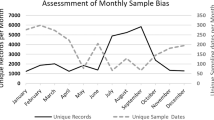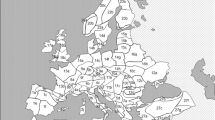Abstract
Regions of mediterranean-type climate represent most extra-tropical biodiversity hotspots, being both highly diverse and highly endangered. Though renowned for their plant richness, these regions’ insects constitute the bulk of their alpha diversities. Data on insect distribution and rarity are generally lacking for such regions, and are often considered unattainable. Intensive field inventories combined with statistical extrapolation methods can provide a sufficient understanding of alpha, beta, and gamma diversity components for application to conservation planning. These are essential to assessing the adequacy of a regional reserve network for the conservation of insect diversity. Here the beetle faunas of three protected areas spanning three major ecoregions in the California Floristic Province were inventoried and analyzed for species richness, complementarity, and uniqueness. These surveys produced collectively nearly 1,200 species from all three sites, estimated to be about 80% of their total faunas. Diversity was highly partitioned among sites, no one site containing more than 60% of the species. Dissimilarity was moderate to high for all comparisons, and all sites contained >40% unique species. Comparison of these results with those based on species of co-occurring plants reveal incongruent species richness but congruent similarities among sites. These results provide quantitative support to the perception that mediterranean insect faunas show high spatial variability. Along with online specimen level data on distribution, rarity, and seasonality, these results will help speed the incorporation of insect data into serious conservation planning.


Similar content being viewed by others
References
Anderson RS, Ashe JS (2000) Leaf litter inhabiting beetles as surrogates for establishing priorities for conservation of selected tropical montane cloud forests in Honduras, Central America (Coleoptera; Staphylinidae, Curculionidae). Biodivers Conserv 9:617–653
Apigian KO, Dahlsten DL, Stephens SL (2006) Biodiversity of Coleoptera and the importance of habitat structural features in a Sierra Nevada mixed conifer forest. Environ Entomol 35:964–975
Basset Y, Springate ND, Alberlenc H-P, Delvare G (1997) A review of methods for sampling arthropods in tree canopies. In: Stork NE, Adis JA, Didham RK (eds) Canopy arthropods. Chapman & Hall, London, pp 27–52
Brown JW, Bash K (2000) The Lepidoptera of Marine Corps Air Station Miramar: calculating faunal similarity among sampling sites and estimating total species richness. J Res Lepidoptera 36:45–78
Burger JC, Redak RA, Allen EB, Rotenberry JT, Allen MF (2003) Restoring arthropod communities in coastal sage scrub. Conserv Biol 17:460–467
Caterino MS (2006a) The California Beetle Database. http://www.sbnature.org/calbeetles. Santa Barbara Museum of Natural History, Santa Barbara (accessed December 2006)
Caterino MS (2006b) California beetle faunistics: 100 years after fall. Coleopt Bull 60:167–191
Chao A, Lee S-M (1992) Estimating the number of classes via sample coverage. J Am Stat Assoc 87:210–217
Chao A, Chazdon RL, Colwell RK, Shen T-J (2005) A new statistical approach for assessing similarity of species composition with incidence and abundance data. Ecol Lett 8:148–159
Colwell RK (2005) EstimateS: Statistical estimation of species richness and shared species from samples. User’s guide and application published at: http://purl.oclc.org/estimates
Colwell RK, Coddington JA (1994) Estimating terrestrial biodiversity through extrapolation. Philos Trans R Soc London B Biol Sci 345:101–118
Cowling RM, Rundel PW, Lamont BB, Arroyo MK, Arianoutsou M (1996) Plant diversity in mediterranean-climate regions. Trends Ecol Evol 11:362–366
Derraik JGB, Closs GP, Dickinson KJM, Sirvid P, Barratt BIP, Patrick BH (2002) Arthropod morphospecies versus taxonomic species: a case study with Araneae, Coleoptera, and Lepidoptera. Conserv Biol 16:1015–1023
Driscoll DA, Weir T (2005) Beetle responses to habitat fragmentation depend on ecological traits, habitat condition, and remnant size. Conserv Biol 19:182–194
Erwin TL (1982) Tropical forests: their richness in coleoptera and other arthropod species. Coleopt Bull 36:74–75
Farrell BD (1998) “Inordinate fondness”: explained: why are there so many beetles?. Science 281:555–559
Ferrier S, Powell GVN, Richardson KS, Manion G, Overton JM, Allnutt TF, Cameron SE, Mantle K, Burgess ND, Faith DP, Lamoreux JF, Kier G, Hijmans RJ, Funk VA, Cassis GA, Fisher BL, Flemons P, Lees D, Lovett JC, van Rompaey RSAR (2004) Mapping more of terrestrial biodiversity for global conservation assessment. BioScience 54:1101–1109
Fisher BL (1999) Improving inventory efficiency: a case study of leaf-litter ant diversity in Madagascar. Ecol Appl 9:714–731
Fleishman E (2005) Identification and conservation application of signal, noise, and taxonomic effects in diversity patterns. Anim Biodivers Conserv 28:45–58
Gering JC, Crist TO, Veech JA (2003) Additive partitioning of species diversity across multiple spatial scales: implications for regional conservation of biodiversity. Conserv Biol 17:488–499
Gotelli NJ, Colwell RK (2001) Quantifying biodiversity: procedures and pitfalls in the measurement and comparison of species richness. Ecol Lett 4:379–391
Grove SJ, Stork NE (2000) An inordinate fondness for beetles. Invertebr Taxon 14:733–739
Hickman JC (1993) The Jepson manual: higher plants of California. University of California Press, Berkeley, p 1400
Hughes JB, Daily GC, Ehrlich PR (2000) Conservation of insect diversity: a habitat approach. Conserv Biol 14:1788–1797
Hutchinson GE (1959) Homage to Santa Rosalia, or why are there so many kinds of animals?. Am Nat 93:145–159
Kremen C, Colwell RK, Erwin TL, Murphy DD, Noss RF, Sanjayan MA (1993) Terrestrial arthropod assemblages: their use in conservation planning. Conserv Biol 7:796–808
Lassau SA, Hochuli DF, Cassis G, Reid CAM (2005) Effects of habitat complexity on forest beetle diversity: do functional groups respond consistently?. Divers Distrib 11:73–82
Latimer AM, Silander JA, Cowling RM (2005) Neutral ecological theory reveals isolation and rapid speciation in a biodiversity hot spot. Science 309:1722–1725
Lawrence JF, Britton EB (1994) Australian Beetles. Melbourne University Press, Melbourne
MacArthur RH, Wilson EO (1967) The theory of island biogeography. Princeton University Press, Princeton
Margules CR, Pressey RL (2000) Systematic conservation planning. Nature 405:243–253
Martikainen P, Kouki J (2003) Sampling the rarest: threatened beetles in boreal forest biodiversity inventories. Biodivers Conserv 12:1815–1831
Marvaldi AE, Sequeira AS, O’Brien CW, Farrell BD (2002) Molecular and morphological phylogenetics of weevils (Coleoptera, Curculionoidea): do niche shifts accompany diversification?. Syst Biol 51:761–785
Marvier M, Kareiva P, Neubert MG (2004) Habitat destruction, fragmentation, and disturbance promote invasion by habitat generalists in a multispecies metapopulation. Risk Anal 24:869–878
Munz PA, Keck DD (1959) A California flora. University of California Press, Berkeley, p 1681
Myers N, Mittermeier RA, Mittermeier CG, da Fonseca GAB, Kent J (2000) Biodiversity hotspots for conservation priorities. Nature (London) 403:853–858
Newton AF, Thayer MK, Ashe JS, Chandler DS (2000) Staphylinidae. In: Arnett RH, Thomas MC (eds) American beetles. CRC Press, Boca Raton, pp 272–418
Novotný V, Basset Y (2000) Rare species in communities of tropical insect herbivores: pondering the mystery of singletons. Oikos 89:564–572
Oliver I, Beattie AJ (1996) Invertebrate morphospecies as surrogates for species: a case study. Conserv Biol 10:99–109
Peck SB, Davies AE (1980) Collecting small beetles with large area window traps. Coleopt Bull 34:237–240
Pik AJ, Oliver I, Beattie AJ (1999) Taxonomic sufficiency in ecological studies of terrestrial invertebrates. Aust J Ecol 24:555–562
Powell JA (1995) Lepidoptera inventories in the continental United States. In: LaRoe E, Farris G, Puckett C, Doran P, Mac MJ (eds) Our living resources. The U.S. Department of the Interior, Washington, pp 168–170
Powell JA, Hogue CL (1979) California insects. University of California Press, Berkeley
Procheş Ş, Cowling RM (2006) Insect diversity in Cape fynbos and neighbouring South African vegetation. Glob Ecol Biogeogr 15:445–451
Raven PH, Axelrod DI (1978) Origin and relationships of the California flora. Univ Calif Publ Bot 72:1–134
Rieske LK, Buss LJ (2001) Influence of site on diversity and abundance of ground- and litter-dwelling coleoptera in Appalachian Oak-Hickory Forests. Environ Entomol 30:484–494
Sala OE, Chapin FS III, Armesto JJ, Berlow E, Bloomfield J, Dirzo R, Huber-Sanwald E, Huenneke LF, Jackson RB, Kinzig A, Leemans R, Lodge DM, Mooney HA, Oesterheld M, Poff NL, Sykes MT, Walker BH, Walker M, Wall DH (2000) Biodiversity: global biodiversity scenarios for the year 2100. Science (Washington, DC) 287:1770–1774
Scharff N, Coddington JA, Griswold CE, Hormiga G, Bjørn P (2003) When to quit? Estimating spider species richness in a northern European deciduous forest. J Arachnol 31:246–273
Schowalter TD, Zhang Y (2005) Canopy arthropod assemblages in four overstory and three understory plant species in a mixed-conifer old-growth forest in California. For Sci 51:233–242
Similä M, Kouki J, Martikainen P, Uotila A (2002) Conservation of beetles in boreal pine forests: the effects of forest age and naturalness on species assemblages. Biol Conserv 106:19–27
Smith CI, Farrell BD (2005) Phylogeography of the longhorn cactus beetle Moneilema appressum LeConte (Coleoptera: Cerambycidae): was the differentiation of the Madrean sky islands driven by Pleistocene climate changes?. Mol Ecol 14:3049–3065
Stebbins GL, Major J (1965) Endemism and speciation in the California flora. Ecological Monographs 35:1–35
Van Dyke EC (1919) The distribution of insects in western North America. Ann Entomol Soc Am 12:1–12
Wolters V, Bengtsson J, Zaitsev AS (2006) Relationship among the species richness of different taxa. Ecology 87:1886–1895
Young DK (1984) Cantharidin and insects: an historical review. Great Lakes Entomol 17:187–194
Acknowledgments
I owe thanks to many colleagues for assistance with this study. For permitting and helping in the fieldwork I thank J. Carson, C. Chapman, E. Claridge, S. Chatzimanolis, T. Dimock, J. Dunn, A. Evans, I. Foley, J. Hogue, J. Iwerks, P. Jump, K. Sharum, A. Short, J. Warner, M. Williams, and The Land Trust for Santa Barbara County. For help with identifications I am grateful to: R. Anderson, F. Andrews, J. Ashe, C. Barr, R. Beal, R. Beiriger, C. Bellamy, C. Carlton, D. Chandler, G. Challet, J. Chemsak, A. Cognato, M. Gimmel, V. Gusarov, C. Hartley, A. Mayor, A. Newton, C. O’Brien, S. O’Keefe, S. Peck, R. Penrose, K. Philips, J. Pinto, M. Price, D. Pollock, V. Puthz, A. Ramsdale, J. Rifkind, P. Skelley, A. Smetana, T. Smith, M. Sörensen, M. Thayer, M. Thomas, B. Warner, S. Wells, K. Will, and D. Young. I also thank K. Fahy, T. Gaffney, R. Muller, N. Rossington, J. Scott, J. Sun, and J. Vicory for help with specimen preparation and data management and analysis. S. Chatzimanolis, K. Fahy, and E. Fleishman provided valuable feedback on the manuscript. This work was supported in part by NSF award DEB0447694 and The Schlinger Foundation.
Author information
Authors and Affiliations
Corresponding author
Rights and permissions
About this article
Cite this article
Caterino, M.S. Species richness and complementarity of beetle faunas in a mediterranean-type biodiversity hotspot. Biodivers Conserv 16, 3993–4007 (2007). https://doi.org/10.1007/s10531-007-9202-6
Received:
Accepted:
Published:
Issue Date:
DOI: https://doi.org/10.1007/s10531-007-9202-6




